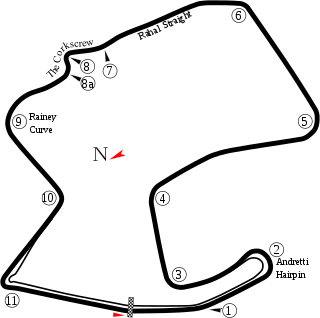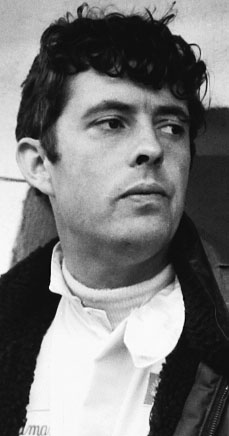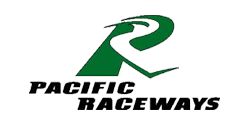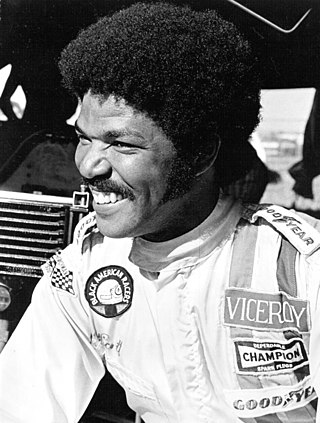The Sports Car Club of America (SCCA) is a non-profit American automobile club and sanctioning body supporting Autocross, Rallycross, HPDE, Time Trial, Road Racing, and Hill Climbs in the United States. Formed in 1944, it runs many programs for both amateur and professional racers.

Laguna Seca Raceway is a paved road racing track in central California used for both auto racing and motorcycle racing, built in 1957 near both Salinas and Monterey, California, United States.
Robert Brett Lunger is an American racecar driver.

Brian Herman Thomas Redman is a British retired racing driver.

Formula 5000 was an open wheel, single seater auto-racing formula that ran in different series in various regions around the world from 1968 to 1982. It was originally intended as a low-cost series aimed at open-wheel racing cars that no longer fit into any particular formula. The '5000' denomination comes from the maximum 5.0 litre engine capacity allowed in the cars, although many cars ran with smaller engines. Manufacturers included McLaren, Eagle, March, Lola, Lotus, Elfin, Matich and Chevron.

Pacific Raceways is a mixed-use road racing and drag racing facility near Kent, Washington. The race track was constructed in 1959 and opened in 1960. The track was originally named Kent Pacific Raceways, then became known as Seattle International Raceways in 1969. After the landowner regained control of the track in 2002, the name reverted to Pacific Raceways.
Francis Anthony Matich was an Australian racing car driver. A highly successful motor racing competitor in the 1960s and 1970s, Matich built his own range of Matich sports cars and open wheel cars, mainly to support his own career, but some cars found success with other drivers. In these and other makes he won five Tasman Series races, two Australian Grands Prix, the 1972 Australian Drivers' Championship and a number of other Australian motor racing titles.

Benny Scott, was a second-generation African American race car driver, a rarity in the motor racing industry. Scott's father, Bill "Bullet" Scott, inspired his son racing midgets in Southern California in the 1930s.

John Walker was an Australian racing driver.
The 1967 SCCA Grand Prix Championship season was the inaugural season of the Sports Car Club of America's championship series for open-wheel, single-seat formula cars, later to be known as the SCCA Continental Championship. The 1967 championship was open to SCCA Formula A, Formula B and Formula C cars, which were limited to a maximum engine displacement of 3.0 liters, 1.6 liters and 1.1 liters respectively.
The 1968 SCCA Grand Prix Championship was the second annual running of the Sports Car Club of America's open wheel automobile racing series later to become known as the SCCA Continental Championship. The championship was open to SCCA Formula A, Formula B and Formula C cars, with Formula A expanded to include vehicles powered by 5 liter production-based engines, with the Formula A category later being renamed to Formula 5000.
The 1969 SCCA Continental Championship was the third annual running of the Sports Car Club of America's professional open wheel racing series. It was the first to carry the SCCA Continental Championship name as the previous two series had both been staged as the Grand Prix Championship.
The 1970 SCCA Continental Championship was the fourth annual running of the Sports Car Club of America's professional open wheel racing series. The championship was open to Formula A cars, with both 305 cubic inch "stock block" V8 engines and 183 cubic inch "free design" engines being permitted in that category. For the first time in the history of the series, drivers competed for the L&M Championship Trophy and a share of a $40,000 prize fund. The championship was won by John Cannon driving a McLaren M10B Chevrolet.
The 1971 SCCA L&M Continental 5000 Championship was the fifth annual running of the Sports Car Club of America's professional open wheel racing series. Liggett & Myers increased its support of the championship for 1971 through its L&M cigarette brand and now had series naming rights.
The 1972 SCCA L&M Continental 5000 Championship was the Sports Car Club of America's sixth annual professional open-wheel auto racing series. It was open to Formula 5000 cars, these being Formula SCCA Class A open-wheel, single-seat cars with 5000cc restricted design engines or 3000cc unrestricted design engines. The championship was won by New Zealand driver Graham McRae.
The 1974 SCCA/USAC Formula 5000 Championship was the eighth running of the Sports Car Club of America's premier open wheel racing series. It was the first to be sanctioned jointly by the Sports Car Club of America (SCCA) and the United States Auto Club (USAC), and the first to be held under the "SCCA /USAC Formula 5000 Championship" name. Sponsorship by the L&M cigarette brand was not carried forward from the 1973 championship.
The 1975 SCCA/USAC Formula 5000 Championship was the ninth running of the Sports Car Club of America's professional open wheel automobile racing series and the second to be sanctioned jointly by the Sports Car Club of America and the United States Automobile Club. The championship was open to cars complying with the SCCA's 5 liter American stock block engine specifications and to cars complying with the USAC's 161 cid turbocharged, 255 cid DOHC or 320 cid stock block engine regulations.
The SCCA Continental Championship was an annual, professional, open-wheel motor racing series organized by the Sports Car Club of America (SCCA), under various names, from 1967 to 1976.
Gerald Jon 'Jerry' Hansen is a former racing driver. Hansen has won a record of 27 SCCA National Championships. Hansen has also competed in Can-Am, the Atlantic Championship, USAC ChampCar among other series.
Edward Hayes "Eddie" Miller was a racing driver from Colorado in the United States. Miller drove for Carl Haas in Formula Ford and Formula Super Vee. He also competed in Formula 5000 and Indy Car until a near fatal crash during practice for the 1976 Indianapolis 500 curtailed Miller's career. Miller won the United States Formula Ford National Championship twice, in 1972 and 1974, and he won the US Formula Super Vee title in 1975.





